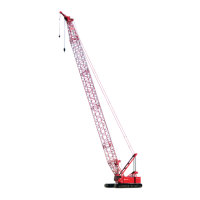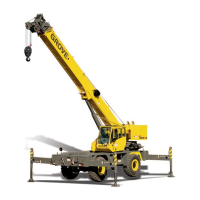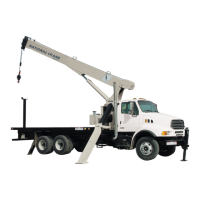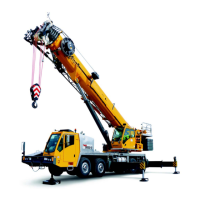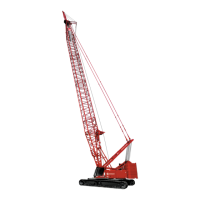Manitowoc Published 06-24-16, Control # 241-01 2-17
2250 OPERATOR MANUAL SAFETY INFORMATION
ASSEMBLING, DISASSEMBLING, OR
OPERATING CRANE NEAR ELECTRIC
POWER AND TRANSMISSION LINES
Electrocution Hazard
Thoroughly read, understand, and abide by all applicable
federal, state, and local regulations regarding operation of
cranes near electric power lines or equipment.
NOTE: For detailed guidelines on operating near power
lines, refer to the current edition of OSHA
29CFR1926.1400 and ASME B30.5 American
National Standard.
• Keep all personnel and their personal belongings
(clothing, water coolers, and lunch boxes) away from the
crane if it is being operated near electrical power lines or
equipment.
• Before operating the crane in the vicinity of electrical
power lines or equipment, notify the power utility
company. Obtain positive and absolute assurance that
the power has been turned off.
The crane is NOT INSULATED. Always consider all
parts of the load and the crane as conductors, including
the wire rope, pendants or straps, and taglines.
Most overhead power lines ARE NOT insulated. Treat all
overhead power lines as being energized unless you
have reliable information to the contrary from the utility
company or owner.
The following rules must be followed at all times, even if
the electrical power lines or equipment have been de-
energized:
• Crane operation is dangerous when close to an
energized electrical power source. Exercise extreme
caution and prudent judgment. Operate slowly and
cautiously when in the vicinity of power lines.
• If the load, wire rope, boom, or any portion of the crane
contacts or comes too close to an electrical power
source, everyone in, on, and around the crane can be
seriously injured or killed.
The safest way to avoid electrocution is to stay away
from electrical power lines and electrical power sources.
• The operator is responsible for alerting all personnel to
the dangers associated with electrical power lines and
equipment. The crane is not insulated. Do not allow
unnecessary personnel in the vicinity of the crane while
operating. Permit no one to lean against or touch the
crane. Permit no one, including riggers and load
handlers, to hold the load, load lines, taglines, or rigging
gear.
• Even if the crane operator is not affected by an electrical
contact, others in the area may become seriously injured
or killed.
• It is not always necessary to contact a power line or
power source to become electrocuted. Electricity,
depending on magnitude, can arc or jump to any part of
the load, load line, or crane boom if it comes too close to
an electrical power source. Low voltages can also be
dangerous.
Setup and Operation
• During crane use, assume that every line is energized
(“hot” or “live”) and take necessary precautions.
• Position the crane so that the load, boom, or any part of
the crane and its attachments cannot be moved to within
6 m (20 ft) of electrical power lines or equipment. This
includes the crane boom and all attachments. Overhead
lines tend to blow in the wind, so allow for movement of
the overhead lines when determining a safe operating
distance.
• Erect a suitable barricade to physically restrain the
crane, all attachments, and the load from entering into
an unsafe distance from electrical power lines or
equipment.
• Plan ahead and always plan a safe route before
traveling under power lines. A wooden clearance frame
should be constructed to ensure sufficient clearance is
maintained between crane and power lines.
WARNING
Electrocution Hazard!
• United States federal law prohibits the use of cranes
closer than 6 m (20 ft) to power sources up to 350 kV
and greater distances for higher voltages unless the
line’s voltage is known [29CFR1910.180 and
29CFR1926.1400].
• To avoid death or serious injury, Manitowoc Cranes
recommends that all parts of crane, boom, and load
be kept at least 6 m (20 ft) away from all electrical
power lines and equipment less than 350 kV.
WARNING
Electrocution Hazard!
Manitowoc Cranes are not equipped with all features
required to operate when the power lines are energized.
Refer to table A clearances in the current edition of OSHA
29CFR1926.1408.
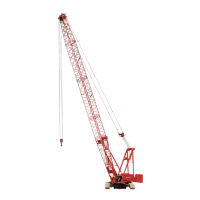
